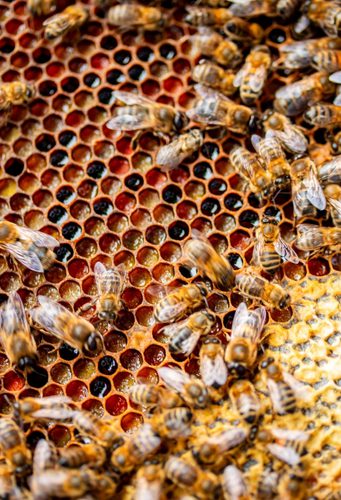

The Johnstons of Elgin Bees
Nestled among the trees and flowers at our Elgin mill grounds, another centre of activity hums with life. Beyond the whirr of our weaving looms is the gentle buzz of a thriving beehive, alive with around 30,000 pairs of tiny wings. Our busy bees are more than just honey makers; they are productive pollinators crucial to our ecosystem.
Beekeeper Rob Mackenzie is one of six volunteers who maintain our flourishing beehive, which was established two years ago. Rob explained that there was a beehive onsite several years ago, and after a break of around a decade, the decision was made to reintroduce one.
‘I’ve hosted several talks to generate interest - around 15 sessions last year with 2-3 people in each. Those who were interested then volunteered to help look after the bees.’



A POPULATION AT RISK
According to Friends of the Earth, the UK has lost around 13 species of bees since 1900, and another 35 are currently at risk. The single most significant cause of bee decline is the intensification of farming, compounded by the increased use of pesticides, especially neonicotinoids, which are devastating wild bees.
Over 250 bee species remain in the UK, from honeybees and bumble bees to solitary bees. Solitary bees love to nest in tiny spaces, and we are delighted to see them buzzing around the nooks and crannies of our heritage buildings. These bees don’t produce honey but are excellent pollinators.

A HIVE OF ACTIVITY
Our hive is home to 20,000 - 30,000 bees, with one queen and a few hundred drones (male bees), easily identifiable by their large eyes and bodies. The remainder are worker bees, all of which are female. The worker bees make the decisions and do the hard work while the drones enjoy the spoils of the workers’ labour.
In early summer, the bees begin to hatch, and as the population increases, they run out of space in the hive. When room becomes tight, the bees 'swarm' and go in search of a new home.
Rob inspects the hive weekly, and if he sees any signs of potential swarming, he will try to delay the process by creating more space inside.

A NEW QUEEN
When swarming happens, the bee colony splits into two – half leaving with the old queen to form a new colony and the other half remaining in the old hive with a new queen.
Despite the dramatic sound and sight of a swarm, the bees aren’t threatening during this process. Before taking flight, they fill up on honey and nectar for the journey ahead to a new home; they are very docile at this time.
GETTING UP CLOSE
Beekeepers can entice bees to fuel up to this calm state so they can safely inspect the hive. When Rob gently pumps a little smoke into the hive, the bees sense there might be a fire and eat as much honey and nectar as they can, filling up for an anticipated move. When the smoke clears, they return to normal work.



POSITIVE IMPACT
We are delighted to use some of the honey from our hive in our onsite coffee shop, Weavers. However, Rob is keen to remind us that honey isn't the only reason to nurture bees, whose pollination efforts help ensure the survival of plants, wildlife and food crops. He adds that the bees and their surroundings also have a positive impact on our community.
‘Johnstons of Elgin is unique in that you have an industrial setting here, but you also have this beautiful garden and flowers. Bees are about so much more than honey. This area encourages people to come out of the office and spend some time outdoors.’
Newsletter
Sign up below for 10% off your first online order, updates about Johnstons of Elgin products, services, stores, events and more.
Customer Service
Visit Us